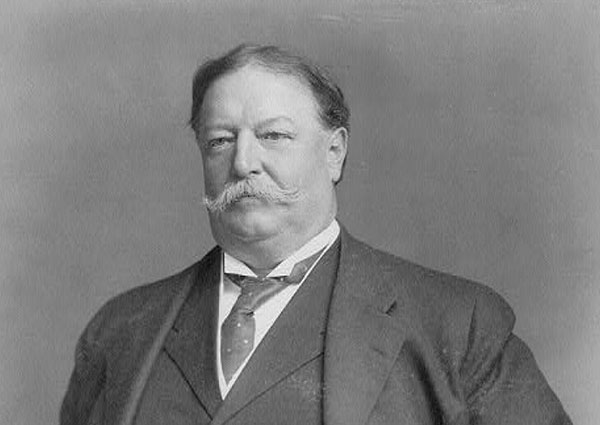William H. Taft was selected by Theodore Roosevelt as Vice Presidential candidate and his successor. Four years later Roosevelt would aid in Taft’s defeat.
William Howard Taft was born in Ohio in 1857 and would go on to become not only President of the United States but also Chief Justice of the United States Supreme Court, a feat unequaled in American history.
Taft’s Early Life
William Howard Taft was born a “city boy” in Cincinnati, Ohio in 1857. As a boy despite his propensity to obesity which would plague him all of his life he was recognized as a good athlete.
He attended local schools and graduated high school as an honors student.
Following high school he attended Yale University and again distinguished himself by graduating second in his class. After Yale, he enrolled in the University of Cincinnati Law School completing his degree and being admitted to the Ohio bar in 1880.
His father Alphonso was a role model for his son William having been a lawyer and the serving as both Secretary of War and Attorney General in President Ulysses S. Grant’s cabinet and later as minister to Austria-Hungary and Russia during the administration of President Chester A. Arthur.
In 1886, Taft married Helen Herron, the daughter of a law partner of President Rutherford B. Hayes.
Aspiring for Judicial Office
Due to his father’s connections, William Taft in 1881 became assistant prosecutor of Hamilton County, Ohio. Following that he became a judge of the Cincinnati Superior Court in 1887. In, 1890 he became United States Solicitor General, the third highest position in the U.S. Department of Justice. A nomination to the United States Supreme Court though not in any way automatic was not beyond a reasonable goal.
In 1892 he receive an appointment as a Judge with the Sixth U.S. Circuit Court of Appeals with jurisdiction over Ohio, Michigan, Kentucky, and Tennessee a post he would continue at until 1900.
Acquaintance with Theodore Roosevelt
While serving in Washington, D.C. He became acquainted with Theodore Roosevelt and in 1897 would convince fellow Ohioan and President William McKinley to name Roosevelt as Assistant Secretary of the Navy.
In 1900 he was named by President McKinley to head a commission to organize a civilian government for the Philippines which had been acquired by the United States in the Spanish American War. He then served a the first civilian Governor between 1901 and 1903.
After the assassination of William McKinley, Taft’s friend Theodore Roosevelt became president. Roosevelt appointed Taft his Secretary of War in 1904. Taft felt this was the job he could do the most good at on behalf of the Filipino people and acted in the same capacity for the people of Cuba. He was also responsible as an overseer for the construction of the Panama Canal.
The Campaign and Election of 1908
After completing the term of William McKinley and being elected president in his own right in 1904, Roosevelt did not feel it was appropriate to run in 1908. Roosevelt decided that Taft should be his successor. Up until the time of the the balloting at the Republican National Convention in Chicago it was really unknown as to whether Roosevelt would change his mind.
Theodore Roosevelt stood by his decision to support Taft despite a reception by the delegates which could have change everything. Taft’s running mate became U.S. Representative James Sherman.
The Democrats nominated William Jennings Bryan and John W. Kern at their convention in Denver. Bryan who had been a candidate for the Presidency in 1896 and 1900 was perceived by the public as a man whose time was in the past. The ticket of Taft and Sherman won handily in the popular vote and carried all but the deep South in the Electoral College.
Taft’s Presidency: 1909-1913
Taft did mean to continue Roosevelt’s progressive program although his programs would involve more administrative action than legislative action. The administrative approach did prove practical when tackling major corporations and “trust-busting”.
In foreign policy, Taft was committed to expanding United States foreign trade. Overall however his policies were unsuccessful perhaps more a result of Roosevelt’s prior interactions in Panama and Santa Domingo.
Although Taft would be nominated by the Republicans in 1912, when Roosevelt entered the race as the Progress or “Bull Moose” Party candidate, Taft’s chances of election were doomed and he would finish in third pace in the popular vote and only receive the electoral votes from Utah.
Taft would later go on to the post in the Supreme Count which he so long desired and served as Chief Justice from 1921 until a mere month before his death in 1930.








